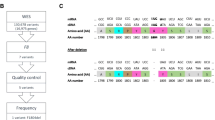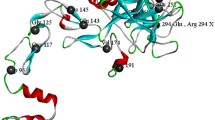Summary
Direct sequencing of the regions of the factor IX gene of likely functional significance was performed in four patients with severe hemophilia B. In two of the individuals, a transition at the dinucleotide CpG caused a nonsense mutation at arginine 333. In the other two individuals, a transition at CpG caused a nonsense mutation at arginine 29. Since these patients are all unrelated, as shown by differing alleles of the TaqI polymorphism in intron four or extensive nonoverlapping pedigrees, the mutations arose independently. In addition, the origin of one arginine 333 mutation in one family has been traced to the germline of the maternal grandfather. The frequent occurrence of mutations at arginine codons that contain the sequence CGN can be explained by the dramatic elevation of transitions at CpG. As a result, approximately one in four individuals with hemophilia B is expected to have a mutation at arginine and nonsense mutations at one of six arginine residues should be common causes of severe hemophilia.
Similar content being viewed by others
References
Antonarakis SE, Kazazian HH (1988) The molecular basis of hemophilia A in man. Trends Genet 4:233–237
Attree O, Vidaud D, Vidaud M, Amselem S, Lavergne J-M, Goossens M (1989) Mutations in the catalytic domain of human coagulation factor IX: rapid characterization by direct genomic sequencing of DNA fragments displaying an altered melting behavior. Genomics 4:266–272
Barrai I, Cann HM, Cavalli-Sforza LL, Barbujani G, DeNicola P (1985) Segregation analysis of hemophilia A and B. Am J Hum Genet 37:680–699
Camerino G, Grzeschik KH, Jaye M, DeLaSalle H, Tolstoshev P, Lecocp JP, Heilig R, Mandel JL (1984) Regional localization on the human X chromosome and polymorphism of the coagulation factor IX gene (hemophilia B locus). Proc Natl Acad Sci USA 81:498–502
Chen S-H, Scott CR, Schoof J, Lovrien EW, Kurachi K (1989) Factor IXPortland: a nonsense mutation (CGA to TGA) resulting in hemophilia B. Am J Hum Genet 44:567–569
Cooper DN, Youssoufian H (1988) The CpG dinucleotide and human genetic disease. Hum Genet 78:151–155
Green PM, Bentley DR, Mibashan RS, Milsson IV, Giannelli F (1989) Molecular pathology of haemophilia B. EMBO J 8:1067–1072
Gyllenstein UB, Erlich HA (1988) Generation of single-stranded DNA by polymerase chain reaction and its application to direct sequencing of the HLA-DQA locus. Proc Natl Acad Sci USA 85:7652–7656
Haldane JBS (1935) The rate of spontaneous mutation of a human gene. J Genet 31:317–326
Ingram GIC (1976) The history of haemophilia. J Clin Pathol 29:469–479
Koeberl DD, Bottema CDK, Buerstedde J, Sommer SS (1989) Functionally important regions of the factor IX gene have a low rate of polymorphism and a righ rate of mutation in the dinucleotide CpG. Am J Hum Genet 45:448–457
Logan LJ (1988) Hemostasis and bleeding disorders. In: Mazza JJ (ed) Manual of clinical hematology. Little, Brown & Co, Boston Toronto, pp 288–314
Saiki RK, Bugawan TL, Horn GT, Mullis KB, Erlich HA (1986) Analysis of enzymatically amplified β-globin and HLA-DQα DNA with allele-specific oligonucleotide probes. Nature 324:163–166
Saiki RK, Gelfand DH, Stoffel S, Scharf SJ, Higuchi R, Horn GT, Mullis KB, Erlich HA (1988) Primer-directed enzymatic amplification of DNA with a thermostable DNA polymerase. Science 239:487–491
Sarkar G, Sommer SS (1988) RNA amplification with transcript sequencing (RAWTS). Nucleic Acids Res 16:5197
Stoflet ES, Koeberl DD, Sarkar G, Sommer SS (1988) Genomic amplification with transcript sequencing. Science 239:491–494
Tsang TC, Bentley DR, Mibashan RS, Giannelli F (1988) A factor IX mutation, verified by direct genomic sequencing, causes haemophilia B by a novel mechanism. EMBO J 7:3009–3015
Vidaud M, Chabret C, Gazengel C, Grunebaum L, Cazenave JP, Goossens M (1986) A de novo intragenic deletion of the potential EGF domain of the factor IX gene in a family with severe hemophilia B. Blood 68:961–963
Vogel F, Motulsky AG (1986) Human genetics — problems and approaches, 2nd edn. Springer, Berlin Heidelberg New York
Winship PR, Anson DS, Rizza CR, Brownlee GG (1984) Carrier detection in haemophilia B using two further intragenic restriction length polymorphisms. Nucleic Acids Res 12:8861–8872
Yoshitake S, Schach BG, Foster DC, Davie EW, Kurachi K (1985) Nucleotide sequence of the gene for human factor IX (anti-hemophilic factor B). Biochemistry 24:3736–3750
Youssoufian H, Kazazian HH Jr, Phillips DB, Aronis S, Tsiftis G, Brown VA, Antonarakis SE (1986) Recurrent mutations in haemophilia A give evidence for CpG mutation hotspots. Nature 324:380–382
Youssoufian H, Antonarakis SE, Bell W, Griffin AM, Kazazian HH Jr (1988) Nonsense and missense mutations in hemophilia A: estimate of the relative mutation rate of CG dinucleotides. Am J Hum Genet 42:718–725
Author information
Authors and Affiliations
Rights and permissions
About this article
Cite this article
Koeberl, D.D., Bottema, C.D.K., Sarkar, G. et al. Recurrent nonsense mutations at arginine residues cause severe hemophilia B in unrelated hemophiliacs. Hum Genet 84, 387–390 (1990). https://doi.org/10.1007/BF00195805
Received:
Revised:
Issue Date:
DOI: https://doi.org/10.1007/BF00195805




